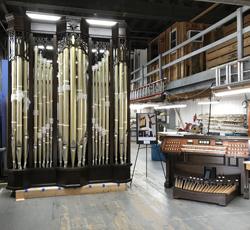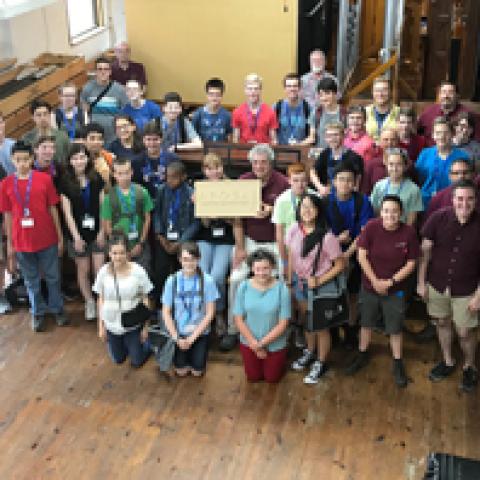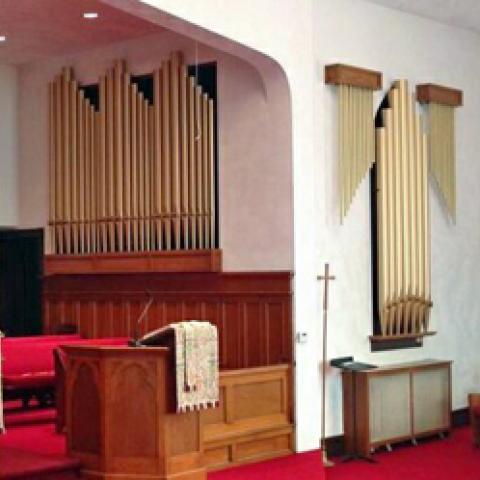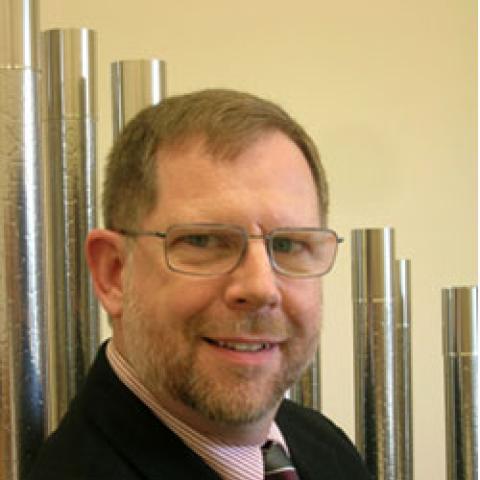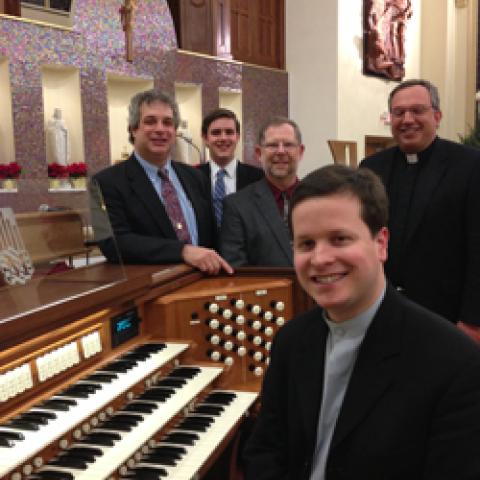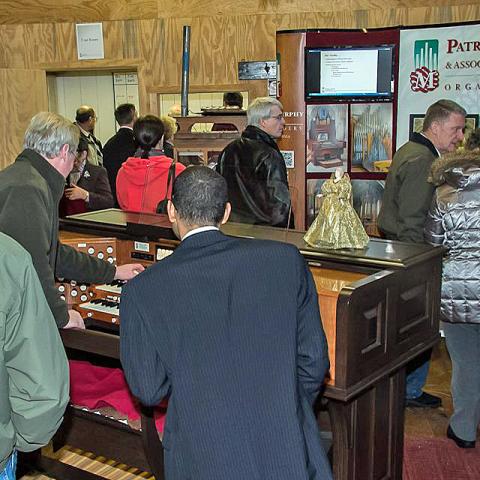R. E. Coleberd
Introduction
In the following narrative, the interaction of an organist and an organbuilder in the design of a new instrument and selection of a builder is described in some detail by each of them. The organist, Jerome Meachen, an Oberlin and Union graduate, was organist/choirmaster of St. John’s Episcopal Church in Waterbury, Connecticut. In 1957 St. John’s, upon the recommendation of Meachen, acquired a 70-rank, three-manual McManis organ. It was followed, when he changed positions, by a 67-rank, three-manual at Redeemer Episcopal Church in Sarasota, Florida (completed in 1966), and in 1973, by a 49-rank, three-manual for Manatee Community College, Bradenton, Florida. The builder, Charles McManis, a trained organist who had apprenticed briefly with Walter Holtkamp before World War II, operated a small shop in Kansas City, Kansas. His skill in flue voicing would become widely recognized and acclaimed in a sixty-year career, which counted more than 125 new instruments and rebuilds.
The discussion highlights the steps in the evolution of their tonal philosophy. It was a process of listening, comparing and choosing sounds and stops in the quest for authenticity in the revolutionary epoch that characterized American organbuilding in the decades following World War II. Before their first meeting, Meachen had acquired a preference for non-legato playing while McManis had been taught the legato style. Despite this difference, the two men found common ground in their admiration and profound respect for the tonal work of William A. Johnson, a legendary nineteenth-century New England tracker builder, and his successors.
Background
The choice of a relatively unknown independent builder in 1956 was decidedly the exception for this era. In the 1950s, pipe organ building in America was the province of the integrated major builders who had controlled the market for new instruments since the turn of the century. M. P. Möller of Hagerstown, Maryland, the “General Motors” of the industry, with a force of more than 400 workers, delivered 365 instruments in 1928 and in the decade 1950-60, with perhaps 200 employees, built 125 organs per year.1 Other builders, those who had survived the drastic shakeout during the Great Depression of the 1930s, were likewise busy, with comparatively large work forces and lengthy backlogs.
In retrospect we might safely say the 1950s, though a vibrant decade, marked the beginning of the end of what could be termed the “commercial” era of organbuilding in America that extended back to the 1920s and perhaps even earlier. Builders, including such highly successful businessmen as Mathias Peter Möller, concentrated almost exclusively on production to meet the enormous market demand in all venues. Company executives, sons of the founder, not musicians, were largely unfamiliar with the great literature for the organ. Sadly, they scarcely comprehended the interface between Bach, Buxtehude and other composers and the subtleties and nuances of fine voicing and finishing in building the King of Instruments. Their instruments were often quite successful in the context of a “production organ,” with uniform and consistent voicing, thanks to the skills of talented shop voicers, but, in retrospect, they were perhaps lacking in artistic statement, which can come only from meticulous tonal finishing. On small organs there was virtually no concept of tonal finishing once the instrument was installed and tuned. Only with the large “signature” instruments was time scheduled for tonal finishing, for example by John Schleigh of Möller and Herb Pratt of Aeolian-Skinner.2
Yet the organ reform movement was underway and gaining momentum, beginning with the pathfinding efforts in the 1930s of E. Power Biggs, Melville Smith, King Covell and others. The major themes are well known: lower wind pressures, smaller scales and higher pitches in flue work and the introduction of chorus in place of solo reeds. A “vertical” tonal palette emerged, featuring a full range of pitches in place of the former “horizontal” palette, dominated by stops of 8-foot pitch. These elements combined in the cohesive blending of individual voices, and the emphasis on ensemble in the building of primary and secondary choruses as reflected in the work of Walter Holtkamp and G. Donald Harrison in the North German and American Classic paradigms.
Leaders in the organist profession, highly educated, widely traveled and well-read, people like Robert Noehren and Parvin Titus, were captivated by the new sounds and ensembles which awakened them to the instrument’s rich music from antiquity. They began paying close attention to European instruments, through travel and recordings, as well as 19th-century work of notable American builders (Hook, Erben, Johnson and others). They wisely looked beyond the stoplist and listened carefully to the sound. The reintroduction of the tracker instrument, first by European builders, followed by an emerging U.S. industry of small shops, reinforced the historic and intrinsic artistic value of the King of Instruments. Steady improvement in the tone quality of the electronic instruments soon spelled the end of the commodity segment of the pipe organ market rooted in the image of an organ as a utilitarian device in support of corporate worship.3
By the end of the century it was recognized that the heart and soul of a pipe organ, a work of art, is the tonal edifice, which begins with a vision and continues through design, voicing and tonal finishing of the instrument. These requirements were most often found in the combined talents of the tonal architect and skilled, dedicated artisans in his shop, seldom in one individual. Harrison, Holtkamp and Fisk, for example, were superb designers but were not voicers. Schopp, Pearson and Zajic were supremely talented reed voicers. But once in a while one individual comprised them all. George Michel of Kimball perhaps came close and, in the author’s judgment, Charles McManis fits this image.
In any revolutionary epoch, change in an established industry comes slowly and sometimes from the outside. American organbuilders, badly shaken by the lean years of the Great Depression and World War II, were to some degree insular, isolated and ingrown. On balance they were reluctant to abandon existing practices and slow to adopt new and untried techniques with unknown consequences. Voicers, trained in-house on high-pressure, wide-scale stops of 8-foot pitch, scarcely comprehended the new generation of flues and reeds. They and their superiors had been disinterested in historic instruments, American and European, which they viewed as antiquated and obsolete. But they could not ignore the revolutionary changes around them, and some firms wisely brought in outsiders--men like Richard Piper at Austin and Franklin Mitchell at Reuter--who were listening and eager to apply their ideas to new stoplists.
At the close of World War II, the demand for organ work far exceeded the supply of qualified people. Factories enjoyed lengthy backlogs and were hard pressed to meet production schedules. Service firms comprised primarily older men, former employees of firms who had failed in the Great Depression--for example, Syl Kohler in Louisville (Pilcher) and Ben Sperbeck and Milton Stannke in Rock Island (Bennett). Honest and hard working, they can best be described as mechanics; few had either voicing experience or any concept of a modern chorus or ensemble. This afforded an opportunity for a newcomer, a young man who had listened carefully, had a firm conviction of what pipe sound should be, and had acquired the voicing skills to bring the sound of a pipe to the tone quality he desired.
Jerome Meachen writes:
A native of Oklahoma City, I studied organ with Dana Lewis Griffin, a student of David McK. Williams at St. Bartholomew’s Episcopal Church on Park Avenue in New York City, and then enrolled at Oberlin College where my teachers were Leo Holden and Grigg Fountain. Holden was a 19th-century organ teacher--Rheinberger, romantic, and very happy with the E. M. Skinner organ in the chapel. His whole approach to organ playing was: “write down the fingering I give you and the registration I want you to use.” It was a very dry--and I felt antiquated--approach. In contrast, Fountain said: “select your own registration from what you hear, we will discuss it and you defend it.” This was essential to broadening my understanding of organ music and what I wanted to develop in my own touch on the instrument. While at Oberlin I practiced on the Johnson organ at Christ Episcopal Church in Oberlin courtesy of Arnold Blackburn, also on the Oberlin organ faculty. This awakened me to the beautiful voicing of this builder. Of course northeast Ohio was Holtkamp country. When I began studying with Fountain, my last two years, he had just obtained a Holtkamp at St. Paul’s Lutheran Church in Cleveland. While I was fascinated with the sounds of this instrument, I found it ear-shattering. I well remember one Saturday afternoon when I was practicing at St. Paul’s. Walter Holtkamp came in, climbed up on the Swell box and said play full organ. He just reveled in the volume, but I found that sort of sound excruciating.
A milestone in my career was a recital at Oberlin by Ernest White. I was fascinated by his approach, non-legato, in contrast to legato, which was the basic style at Oberlin. Legato evolved because of the acoustics organists had to deal with in American churches. Nothing happened after you took your finger off the note so you had to pull everything together.
After graduating from Oberlin I enrolled in the School of Sacred Music at Union Theological Seminary in New York City, where I arranged to study with Ernest White, then an adjunct faculty member. We shared a common interest in repertoire and liturgy. White had me listen to orchestral recordings of Mozart and commented: remember, “Bach was a violinist as well as an organist.” Bob Clark, another graduate student, and I found White way ahead of his time in non-legato sound, which broadens your understanding of the organ. This is the sound one finds in Europe and what we were striving for in America. Working with White was working with the literature and developing the capacity to do his particular style of non-legato in terms of liturgy, the Anglican approach and plainsong. This was very enlightening to me. I was fascinated by White’s approach to playing the studio organ at St. Mary the Virgin, the second studio instrument, this one by Möller. His technique was a detached sound, like the ringing of bells. Unfortunately, the voicing was so loud it was difficult to listen to. This alerted me to the distinction between intensity and decibels, a key distinction in my thinking. I was also intrigued by the design of the organ, which had a 32’ Cornet using individual stops and two Swell boxes providing two ensembles. This inspired the use of separate swell boxes and couplers for flues and reeds at St. John’s. My admiration for Johnson continued when I practiced on their instrument at the Mott Haven Dutch Reformed Church in the Bronx while at Union.4
Charles McManis writes:
As a pre-teenager in Kansas City in the 1920s, with my parents I often rode the streetcar to Independence Boulevard Christian Church to hear Sunday afternoon recitals by the legendary Hans Feil on the four-manual, 1910 Austin organ. In the 1930s while I was a student at the University of Kansas, I spent summers and holidays working with Peter E. Nielsen, a local serviceman, tuning and rebuilding pipe organs. Two of these instruments were Johnson trackers from the 1880s.5 They were especially impressive and were to influence fundamentally my concept of voicing.
Enrolling as a liberal arts major at the University of Kansas in Lawrence I became a student of University Organist Laurel Everette Anderson, an Oberlin master’s graduate who then studied for three years in Paris with Joseph Bonnet. He taught the legato method, and emphasized proper turning of phrases and making real music out of notes. He greatly expanded my knowledge of the pipe organ and emphasized nuances of color and singing quality in organ voices. Following graduation with an A.B. degree in 1936 and having already set my sights on becoming an organbuilder, I obtained a Mus.B. at KU in 1937, which required my playing an hour-long recital from memory. The thought occurred to me that I might be the first organbuilder who could play more than “Yankee Doodle” on what he had built.
I began my organbuilding career with a shop in the basement of my parents’ home. I rebuilt three organs and built one new instrument. My Opus 2, 1939--electrifying and adding nine ranks to a 1910 tubular-pneumatic Kilgen--is still playing in the Central Christian Church in Kansas City, Kansas. Then, having learned of his growing prominence in the organ reform movement, I apprenticed with Walter Holtkamp in Cleveland for a few months, eager to learn from him. I assisted with the installation of a three-manual Holtkamp organ at Olivet College in Michigan. It had Great and Positiv slider chests, but the Swell had ventil stop-action for want of sufficient space for a slider chest. When I compared the sounds of slider chest pipes and those on the ventil chest I was surprised to find that I could hear no difference. Walter’s instruments were visually well designed and beautiful to look at but, frankly, I was disappointed with his ensemble sound and tone quality. The voicing lacked a certain richness of tone. In checking Holtkamp pipes I noticed that he nicked only on the languids and not on the lower lips. As a result, pipes occasionally tended to emit an abnormal squeaking sound. He was not interested in building a truly classic organ as much as building a distinctive Holtkamp organ. In retrospect I find that I employed very few of Holtkamp’s ideas in my later work. Based on my background in music, I wasn’t hearing in his organs the sounds I wished to hear in my own instruments.
Following the attack on Pearl Harbor and the U.S. entry in World War II, I enlisted in the Army. Prior to shipment overseas my outfit was stationed at Camp Kilmer, New Jersey, for a few days. I went on pass to New York City to hear G. Donald Harrison’s new Aeolian-Skinner in the main sanctuary of St. Mary the Virgin Episcopal Church. This was my first acquaintance with mixtures and upperwork, which Laurel Anderson had talked about at KU, but which were conspicuously absent in the Austin organ in Hoch Auditorium there. Then, as a chaplain’s assistant, I was stationed in Europe where I took every opportunity to play and inspect European instruments. I remember, in particular, the famous Cavaillé-Coll instrument in the church of St. Ouen at Rouen, which inspired Guilmant’s Eighth Organ Symphony. This was the first time I had seen a five-rank mounted cornet and reeds with sunken blocks in the boots.6 After the war I returned to Kansas City, Kansas and set up shop again. On one occasion, being in New York City, I attended a recital given by Ernest White on his new Möller studio organ at the Church of St. Mary the Virgin. I left at intermission because the organ was painfully loud. In my voicing I try to make a rank of pipes only as loud as needed to ping the tone off the walls, blowing only hard enough to fill the room at the desired volume.7
Jerome: Following graduation from Union, I was appointed organist/choirmaster at St. John’s Episcopal Church in Waterbury, Connecticut. When we went looking for a new instrument to replace the 1869 Hook & Hastings, I wasn’t enamored with the sounds of Holtkamp, Möller, Schlicker and Austin, and mentioned my dilemma to my good friend Bob Clark, whose judgment I valued. He was organist at the Peddie Memorial Baptist Church in Newark, New Jersey, where my wife was soloist, having the best-paying solo position in the area, while I was at Union. He said, “Why don’t you check with Charles McManis, who builds organs that sing and don’t shout.” When I learned he was in Danbury, Connecticut, I went down to get acquainted, and we hit it off immediately.
Charles: In the early 1950s I became acquainted with Robert Noehren through our writings in The Diapason and The American Organist magazines. I worked for him on the Hill Auditorium Skinner in Ann Arbor, and built a new organ for Frankenmuth, Michigan, where he was the consultant. When he was named consultant on the Johnson at Emmanuel Lutheran Church in Danbury, Connecticut, whose organist had been his student at Michigan, I was called in. My strong feelings concerning Johnson flue pipe voicing began during my apprenticeship days in Kansas City. I discovered that diapason pipes mouth-blown very gently, then increased to full volume, had scarcely any change in pitch. Volume was regulated at the toe hole, not by opening the flue. In contrast, classical open toe voicing regulated volume at the mouth, which I found totally inadequate. I revoiced the 8-foot Principal, increasing its richness of tone, primarily by opening the toes and, to a lesser degree adjusting the mouths. Jerry and I connected as musicians, no doubt in part because I too had a degree in organ. We both agreed on what we didn’t like. I obtained the contract for the St. John’s, Waterbury, organ (see photo and stoplist) in part because Parvin Titus was the consultant. The St. John’s rector, Rev. John Youngblood, had been a curate in Cincinnati, knew Mr. Titus and trusted his judgment. Also, I had built the new instrument for the Second Church of Christ, Scientist in Dayton, where Titus also had been the consultant.
Jerome: The Johnson sound was already in my head, not only from Oberlin, but from the fine Johnson in Mott Haven Dutch Reformed Church in the Bronx, where I first practiced when I went to New York. I explained that we were looking for intensity not decibels in organ sound, colors and ensembles that sing. Charles showed me what he was doing. It was soon obvious this was just the ticket for us. These initial impressions were confirmed when my wife and I visited St. Paul’s Episcopal Church in Kansas City, Kansas, and heard for the first time a complete McManis instrument. All the voices were exquisite; the 8-foot principal was a well-supported, big baritone sound. Having worked in training choirs at an early age, striving to blend individual voices, I found in the lovely individual voices of this organ an exquisite ensemble and chorus.
Charles: When Jerry came to Kansas City, the mixtures and ensemble sounds on the Great and Swell at St. Paul’s were what really got to him. The voices together on each manual resulted in contrasting sounds but very much related. We talked at length about voicing and drew up a specification for a three-manual instrument for St. John’s. (See specification.) I also discussed what I had done in reworking old pipes and changing pitch. This was very important because in the 1869 Hook & Hastings at St. John’s a number of old ranks were reworked.
I first saw Waterbury after Meachen returned from Kansas City, and was dismayed to find dry acoustics and such terribly large scales in the Hook & Hastings. The only principal stop I could use was the 16-foot on the Great, which would work well in the Pedal division. We were able to cut down and revoice a number of 8-foot stops; for example, the 4-foot principal on the Swell had been an 8-foot violin diapason. If the scale and mouth treatment were correct, the desired sound would follow.
Let me quote from my forthcoming autobiography to explain the tonal philosophy of this instrument: “The classic Werkprinzip theory of terraced manual pitches had not yet hit the AGO cocktail hour conversation when Jerry and I drew up the design for Opus 35 (St. John’s Church Waterbury, CT) on that Sunday afternoon. Submitted to organ consultant Parvin Titus, he heartily approved of the design, but suggested inclusion of the rather outstanding Oboe from the 1869 H&H. But back to the Werkprinzip! While numerous other stops are needed in each division, the backbone is the Principal chorus, as shown below:
I: Great 8’ Principal 11/3’ Mixture
II: Swell 4’ Principal 2/3’ Scharf
III: Brustwerk 2’ Principal 1/3’ Cymbel
Pedal 8’ Principal 11/3’ Mixture
For purposes of contrapuntal clarity, the Pedal chorus should be the same pitch as the Great, plus suitable 16’ underpinning. Polyphony does better without the growl of a sub-octave mixture cluster.”
After the tornado hit downtown Waterbury in July, 1989, heavily damaging the St. John’s organ, I replaced 35 ranks of pipes including replacement of the Brustwerk Singend Regal with a brass Krummhorn and substitution of a Swell 4’ Clarion for the earlier 4’ Krummhorn. Also, the 32’ extension of the Pedal reed was linked to the Posaune instead of the Contrafagotto.
Jerome: Another factor which impressed me about the McManis was its compatibility with what I call a theatre sound by which I mean, it had to dance. In the theatre organ you had a detached pedal and a strong emphasis on the melodic line when you are thinking bass line and melody. This is why I was very comfortable doing figured bases. It was non-legato; it was instrumental. When you were featuring the posthorn, you were quite willing to detach it. My father loved theatre organ, so from the time I started playing, I developed something of a theatre style. Searle Wright, the well-known organist at St. Paul’s Chapel, Columbia University, also did a great theatre style.
Charles inspired my definition of intensity because he viewed the entire instrument as a whole. In a three-manual you could draw the principal and mixture on each division, couple them together and you had a basic ensemble evoking a very intense, rich but not very loud sound because you didn’t have to fill in and thus did not have an awful lot of stops working. Thus the concept of full organ was very discriminating; the full organ piston didn’t bring on everything. You are dealing with colors and when you put everything on you end up with brown or gray. And with a tremolo on each division if you wanted to cantus firmus you could do it anywhere in the instrument.
This instrument fulfills my belief in the theological aspect of an organ. With my developing interest in liturgy I was very much aware of the person in the pew. I hold that the organ must be people-friendly, in support of congregational singing whether it be chant or hymnody. Surrounding rather than hitting the congregation with sound--making a joyful noise, not just a noise. Charles spoke of attending a recital on the Möller practice organ at St. Mary the Virgin in New York and finding it so loud he left after the first half of the program. I agree. White offered me a chance to practice on that organ but I told him I would be using only one or two stops so I might as well practice on the chapel organ. The sound was so high in decibels I couldn’t hear it.
Redeemer and Manatee
This paper has focused on the St. John’s organ. Those at Redeemer Episcopal Church and Manatee Community College continued the fundamental practices in the philosophy of McManis and Meachen. They also reflected modifications and forward thinking in their approach, as did the rebuilding and restoration of St. John’s in 1989.
At Redeemer in Florida, the former ten-rank Möller, with its subsequent addition of nineteen Aeolian-Skinner ranks, was skillfully integrated into the 67-rank new instrument. In place of the 16’ Quintaton on the Great, they chose a 16’ Gemshorn mounted on the chancel wall, extended to an 8’ Gemshorn and a 4’ tapered flute in a seamless tonal progression. The Great and Positiv exposed chests were equipped with toeboard expansion chambers to increase richness of tone.
The 49-rank Manatee Community College organ was installed in Neel Auditorium at the point of a pie-shaped building on a 35-foot shelf at the back of the stage. In an obviously “werkprinzip” layout (see photo, page 20), in a variety of shapes, it was enclosed in a mahogany case. The 16’ Pedal Principal exposed at the center hid the movement of Swell shutters behind. To its left were the lower notes of the 16’ Subbass and 16’ Posaune; to the right, the pipes of the Hooded Trumpet and more Subbass metal pipes. To the far left in the left façade was the Great 8’ Principal, and to the far right the 4’ Positiv Principal in the façade. Roofs of the façades differed but all were related to the focal point mentioned above.
The Manatee Great included a 16’ Gemshorn, all the usual 8’ and 4’ stops, plus a normal 11/3’ Mixture, a 2/3’ Acuta, and an 8’ Trumpet. The Swell mixture was a 1’ Scharf and the Positiv had a 1/3’ Cymbel. The thoroughly adequate Pedal division included a 32’ Dulzian and the usual 8’ and 4’ ranks. As would be expected, the Pedal mixture lowest pitch was 11/3’, but pipe scales were larger than those of the Great Mixture.
Summary
The above dialogue illustrates the way in which the concept of organ sound in the mind of an organist and soon-to-be builder begins with formal study of the instrument and is heavily influenced by the instructor and his experience. With this background, they are then prepared to compare and contrast a wide variety of sound in determining their own definition of it: for Meachen and McManis, a singing sound. It also argues that the ultimate test of the voicer’s art, be it Johnson or McManis, is the 8’ Diapason found on the Great, a belief shared by organists and builders for many years.
In an article in The Diapason, based upon his lecture to the AIO Convention in Pittsburgh in 1977, McManis explains the details of flue voicing and the practices of Tannenberg, Gratian, Kilgen, Hook & Hastings, Johnson, Wurlitzer, Estey (William E. Haskell), Cavaillé-Coll, and Kimball.8 This paper, now considered a classic, together with the recognition of his peers in his selection as instructor in flue voicing at a seminar of the American Institute of Organbuilders, established him, in the author’s judgment, as one of the finest flue voicers of the twentieth century.9
Charles passed away, at age 91, on December 3, 2004 in South Burlington, Vermont. Providentially, he and his wife Judith had just completed his autobiography. It contains vivid recollections of personalities and detailed descriptions of his instruments in a sixty-year career that spanned the arc of the postwar history of organbuilding in America. This priceless volume is scheduled to be published by the Organ Historical Society in 2005. It will find a prominent place on the shelf of every organist, organbuilder and organ enthusiast.
For research assistance and critical comments on drafts of this paper, the author gratefully acknowledges: Gene Bedient, Jerry Dawson, Charles Eames, Donald Gillette, Albert Neutel, Barbara Owen, Michael Quimby, Elizabeth Schmidt, Jack Sievert and R. E. Wagner.
